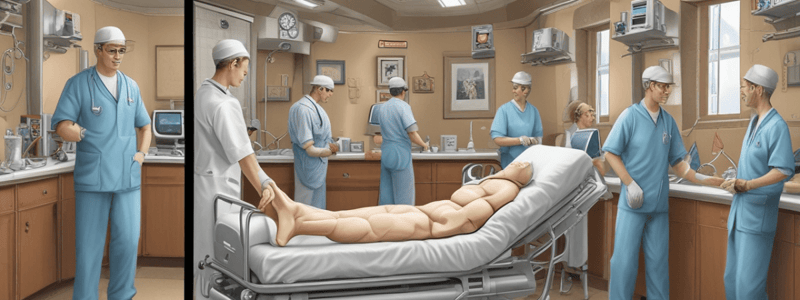Podcast
Questions and Answers
What is the primary goal of nursing assessment in the perioperative experience?
What is the primary goal of nursing assessment in the perioperative experience?
- To administer medication
- To monitor vital signs
- To ensure the safety of the person (correct)
- To diagnose the patient's condition
What is the process by which a fracture is restored to its normal anatomical structure and function?
What is the process by which a fracture is restored to its normal anatomical structure and function?
- Bone remodeling
- Fracture healing (correct)
- Fracture repair
- Osteogenesis
Which of the following is a common complication of fractures?
Which of the following is a common complication of fractures?
- Deep vein thrombosis
- Infection
- Compartment syndrome (correct)
- Fat embolism
What is the purpose of immobilization in fracture repair?
What is the purpose of immobilization in fracture repair?
What is the primary focus of the nursing process in the perioperative experience?
What is the primary focus of the nursing process in the perioperative experience?
Flashcards are hidden until you start studying
Study Notes
Blunt Tissue Injuries, Sprains, and Strains
- Aetiology: caused by direct blows or trauma, leading to damage to soft tissues, such as muscles, tendons, and ligaments
- Pathophysiology: involves inflammation, swelling, and pain due to bleeding and edema
- Clinical manifestations: pain, swelling, bruising, and limited mobility
Fractures
- Aetiology: caused by excessive force, twisting, or trauma, leading to bone breakage
- Pathophysiology: involves disruption of bone architecture, leading to bleeding, inflammation, and pain
- Clinical manifestations: pain, swelling, deformity, and limited mobility
Fracture Healing
- Process: inflammation, soft callus formation, hard callus formation, and bone remodeling
- Inflammation: initial response to injury, involving bleeding and swelling
- Soft callus formation: cartilaginous matrix forms at fracture site, providing some stability
- Hard callus formation: bony tissue forms, replacing cartilaginous matrix, providing greater stability
- Bone remodeling: final stage, where bone is reshaped and restored to its original form
Immobilization for Fracture Repair
- Forms: casts, splints, and internal fixation devices
- Comparing and contrasting:
- Casts: provide external support and immobilization, limiting mobility
- Splints: provide external support and immobilization, allowing for some mobility
- Internal fixation devices: provide internal support and stabilization, allowing for early mobilization
Compartment Syndrome
- Definition: a condition where increased pressure in a muscle compartment leads to decreased blood flow and nerve function
- Causes: fracture, trauma, or surgery
- Clinical manifestations: pain, numbness, tingling, and weakness
- Nursing management:
- Monitor for signs and symptoms
- Maintain elevation and immobilization
- Provide pain management
- Monitor for complications
Perioperative Care
- Purpose of nursing assessment: to identify potential risks and complications
- Components of nursing assessment:
- Preoperative: medical history, physical examination, and laboratory results
- Intraoperative: monitoring of vital signs and anesthesia
- Postoperative: monitoring of vital signs, pain, and wound healing
- Nursing process:
- Assessment: identify potential risks and complications
- Planning: develop a plan to prevent complications
- Implementation: implement interventions to prevent complications
- Evaluation: monitor and evaluate the effectiveness of interventions
Studying That Suits You
Use AI to generate personalized quizzes and flashcards to suit your learning preferences.




